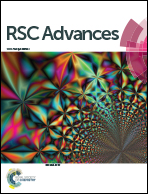Candida rugosa lipase immobilization on magnetic silica aerogel nanodispersion†
Abstract
In this work, a magnetic silica aerogel support was prepared by iron oxide nanoparticles and sodium silicate precursors in a sol–gel process followed by chemical surface modification and ambient pressure drying. Immersion of the silica gels in nanoparticles alcoholic solution was used to synthesis nanocomposites. Characterizations of synthesized samples by BET, FE-SEM, TEM, FTIR, XRD and VSM showed the homogeneous surface morphology, the large surface area (520 m2 g−1), mesoporosity, superhydrophobicity and ferromagnetic property which are the attractive properties of magnetic aerogels as supports for lipase immobilization. The synthesized nanocomposites were dispersed in alcoholic solution and used to immobilize Candida rugosa lipase by adsorption method. The influence of the sonication amplitude and time in lipase immobilization yield and activity were studied using response surface methodology (RSM). Comparison between the performance dispersed and non-dispersed supports revealed the positive effect of dispersion process on immobilization yield and enzyme activity. The success of immobilization was confirmed by confocal laser scanning microscope (CLSM), proving that enzyme is well distributed in the dispersed magnetic silica aerogel. A comparative study between free and immobilized lipase on dispersed support, was conducted in terms of pH, temperature, thermal stability and the kinetic parameters. Maximum adsorption capacity of lipase was estimated as 81.9 mg g−1 based on Langmuir isotherm.


 Please wait while we load your content...
Please wait while we load your content...